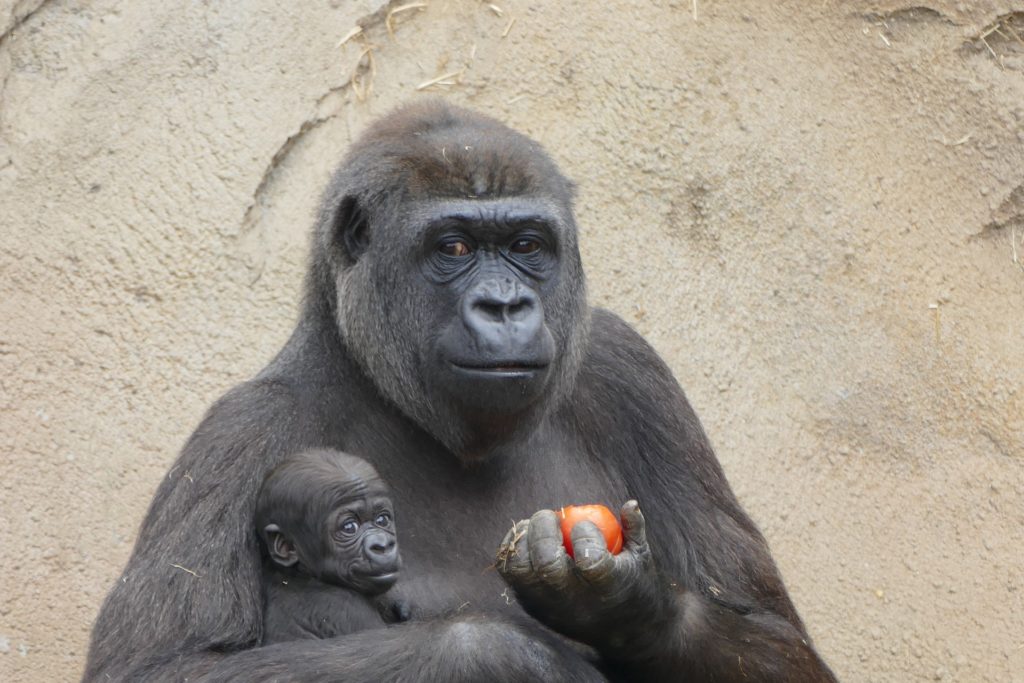When I got pregnant, no one, whether doctor or fellow mom, said, “Oh! Pregnancy will be wonderful for your back!”
Back pain is a well-known symptom of pregnancy. But since my existing back problems are hard enough to manage, I wanted to know what exactly would change with pregnancy. Would it exacerbate my existing problems, or put me at risk of new ones? Was there anything I could do to prepare myself?
In my search for answers, I found an article that helpfully described how women’s spines have evolved to deal with the stresses of being pregnant and walking upright. It’s nice to know that evolution foresaw my pregnancy-related back problems, and gave me some tools to deal with them.
Although this article, Fetal load and the evolution of lumbar lordosis in bipedal hominins, didn’t tell me how to prevent back pain in pregnancy, it told me a great deal about the changes I could expect as my baby grew from the size of poppy seed to the size of a watermelon.
(Fun Fact: One of the paper’s co-authors, Prof. Daniel E. Lieberman, was the first to propose that humans evolved to be endurance runners. He also helped popularize the barefoot running exercise trend.)
Childbirth: An Evolutionary Non-Negotiable
In previous articles, I’ve noted that bipedalism still wreaks havoc on our imperfectly-adapted bodies, and that our spine is an evolutionary compromise.
One vexing problem in human anatomy is that women have to be able to give birth, and we didn’t evolve to do it through caesarian section. Other organs must be reconfigured to let a baby pass through the birth canal, even if the tradeoffs are wildly inconvenient.
During a symposium at Boston University, Dr. Bruce Latimer illustrated one of the design problems:
The sacrum is nearly horizontal. If you were going to design a spine, starting from scratch, you would make it vertical. But we couldn’t make it vertical. Evolution couldn’t do that because we have to maintain the birth canal. So we keep it in its horizontal position. And that is why we have to have that lordotic curve.
(Side note: That lordotic curve serves other purposes, such as helping us absorb the forces generated when walking or running.)
Human Babies Are Heavy
Compared to other primate babies, human newborns are heavy. The article notes that, “Pregnancy augments the mass of the human female abdomen by as much as 31% (6.8 kg).”
That’s a lot of extra weight to add in a relatively short time. And while we humans may find this development normal, we’re outliers among primates. In the same Boston University symposium, Dr. Karen Rosenberg noted that:
Although they may seem tiny to first-time parents, human newborns are big relative to their mothers compared to other primates. Gorilla newborns average about 2.7% of their mother’s body size. Chimpanzees, about 3.3%, and human newborns about 6% of the size of their mothers. This fact accounts for some of the costs associated with carrying human babies around in utero and of course after they’re born as well.
You can bet I will cite this statistic to my husband at every possible opportunity. Especially when I’m crawling under the bed to pick up his socks.
But despite their size, and the time they’ve spent in the womb, even full-term human babies aren’t really finished gestating. Gorilla babies are born with brains that are already 45% of their adult size, and chimpanzee babies are born with brains 40% as large as an adult’s. In comparison, human babies have tiny brains – at birth, our brains are only 29% of their adult size.
After watching my friends and acquaintances go from expecting to actual mothers, I realized that childbirth didn’t free them from carrying their babies, even when it was wildly inconvenient.

Recentering the Pregnant Self
I don’t know whether chimpanzee mothers suffer from nosebleeds, nausea, mood swings, or other discomforts of pregnancy. But whatever chimps go through during pregnancy, they are not knocked off balance the way human females are. Pregnant chimps may have bigger bellies, but because the baby is suspended nicely beneath their spines, their center of gravity remains the same.
In contrast, human women carry their babies on their front, and the weight of the baby pulls the center of gravity forward.
While it is actually possible for heavily pregnant women to keep the same posture they did before pregnancy (using their muscles to compensate for the extra load), this puts additional pressure on the hips, compromises balance, and quickly fatigues the muscles.
Instead, pregnant women will normally compensate for their changing center of gravity by increasing their lumbar lordosis (the curve at the bottom of the spine). This posture is easier to maintain, since it brings the center of gravity back over the hips.
Alas, it does come with a cost, which is paid by the spine. It increases the shear forces on the vertebrae, and especially the facet joints. Normally, the facet joints absorb only about 16% of forces placed on the vertebrae, but that proportion can increase to 20–40% in pregnant women.
Even in non-pregnant humans, these types of shear forces can cause painful and irreversible back problems. In Low Back Disorders, McGill notes that the endplate can actually pull away from the rest of the vertebral body.
Also, the ligaments of the spine can be damaged, and the bony arch at the back of the vertebrae can fracture, or break entirely, which can lead the top vertebrae to slip down over the lower one. (These sorts of injuries are also common in certain types of athletes, such as gymnasts and cricket bowlers, who do a lot of backward and forward bending.)
Obviously, it is not reproductively advantageous for woman to develop permanent and debilitating back pain as soon as she reaches her third trimester. How then, do women avoid this?
The Special Design of the Female Spine
The really interesting part of this story is that women’s spines are built differently than men’s, in ways that help them better cope with pregnancy.
First, their lumbar vertebrae have a different shape. Most human vertebrae tend to be slightly wedged, though the angle of this wedging is different at different vertebral levels. These assorted shapes give our spine its characteristic S-curve.
In men, only the L4 and L5 vertebrae are wedged so that the back of the vertebra is narrower than the front. This creates lumbar lordosis. But women have three lordotically wedged vertebra – L3, L4, and L5. This means that when a woman leans back, she puts less stress on the individual vertebra than a man would.
Women also have proportionately larger facet joints in their lumbar vertebrae than men. On average, women’s facet joints have 14% greater surface area than men’s, compared to the total size of their vertebrae.
Women’s facet joints are also set at a different angle. They point upward at an angle that is 13% greater on average than in men. This angling, combined with the larger joint surface area, helps women handle the larger shear forces that are placed on the lumbar vertebrae during pregnancy.
It’s possible, although not conclusive, that these adaptations have been in place longer than Homo sapiens has existed as a species. There is some evidence that the bipedal Australopiths had a similar pattern of male/female spine design difference some two million years ago. However, fossil vertebrae are fragile, and scientists don’t have enough good specimens to draw definite conclusions.
While I may not be able to avoid many unpleasant pregnancy symptoms, it’s nice to know that evolution, anyway, has my back.
References
- Boston University. 2019. Boston University Dialogues in Biological Anthropology Number 6 – Part 1. April 2. Accessed January 6, 2021. https://www.youtube.com/watch?v=QKL061Rnk-I.
- McGill, Stuart. 2016. Low Back Disorders: Evidence-Based Prevention and Rehabilitation. Third Edition. Human Kinetics.
- Whitcome, Katherine K, Liza J Shapiro, and Daniel E Lieberman. 2007. “Fetal load and the evolution of lumbar lordosis in bipedal hominins.” Nature 450 (7172): 1075–1078. doi:10.1038/nature06342.
